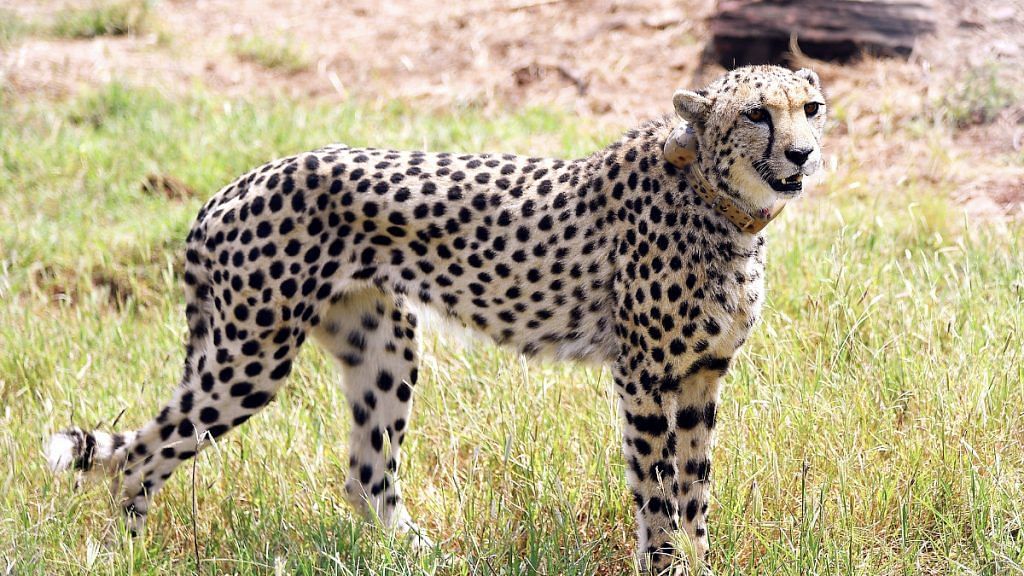New Delhi: The South African Ministry of Forestry, Fisheries and the Environment has “approved” the Memorandum of Understanding with India on the transcontinental introduction of cheetahs, and it is now awaiting the signature of President Cyril Ramaphosa, multiple sources familiar with the matter have told ThePrint.
The 12 cheetahs picked for transfer have been in quarantine since July and conservationists are now concerned about their fitness.
In September, India received eight cheetahs from Namibia in the world’s largest conservation trial, which seeks to establish a free-ranging population of the species 72 years after it was declared extinct in India. The project has drawn controversy, dividing conservationists across the world.
India had announced last year that it would source cheetahs from both Namibia and South Africa, but the latter has held off on officially signing the agreement so far. The South African government sent a delegation of experts to inspect Kuno National Park, Madhya Pradesh, where the Namibian cheetahs were released, between 6 and 8 September. The committee’s report has been submitted to the South African government, and according to sources, was “received positively”.
With South African Minister of Environment, Forestry and Fisheries, Barbara Creecy’s approval, officials and experts involved in the process are hopeful that 12 cheetahs from South Africa will arrive in India by early next year. The selected cheetahs have been in quarantine since 15 July.
“It is vital the cheetahs are shifted by January because they are losing time and fitness in quarantine. Cheetahs are not supposed to be in confined spaces for this long,” said an expert who did not wish to be named. Once the cheetahs are shifted, they will have to spend a month in quarantine in India as well.
Officials from the Indian government last met with their South African counterparts to discuss the project on 29 November, an Indian government official said.
“There has been a lot of bad press around the project. It seems they were keen to see how the cheetahs from Namibia responded to their new environment,” the official said, adding, “We expect the South African cheetahs to be here by early next year.”
Albi Modise, spokesperson for South Africa’s Ministry of Forestry, Fisheries and the Environment said he could not comment on the matter at the moment, and said the MoU has not yet been signed.
Also Read: ‘Speed of a cheetah’ — read the subtext. Modi’s ‘pet’ project is heavy with political messaging
8 cheetahs adjusting ‘well’
According to officials in the Madhya Pradesh forest department and Union Environment Ministry, the eight Namibian cheetahs are adjusting well to their new environment. They have been released from quarantine into larger fenced enclosures, and five have made a kill. They will be released into the wild once they have fully acclimated, according to the Cheetah Introduction Plan.
“We moved the animals out of quarantine in stages, because we wanted to make sure they were doing well, and not put them all out at the same time,” said Laurie Marker, executive director of Cheetah Conservation Fund, the organisation that coordinated their translocation from Namibia. “I think the cheetahs are adjusting very well because they’re hunting and learning their new area.”
J.S. Chauhan, chief wildlife warden of Madhya Pradesh, agreed, saying “The cheetahs are doing much better than we anticipated. Most have already killed prey.”
Forest staff use a combination of satellite imagery and transmitters and receivers to detect each cheetah’s movements. One physical sighting is also necessary, according to current protocols.
“They’ve displayed a sense of alertness and seem to be adjusting to their new surroundings well,” said the government official quoted above, adding, “The real challenge is how they will survive and how we will track them once they are released into the wild.”
Several wildlife experts and conservationists have raised concerns about the project, given the cheetahs will be in competition with an outsized leopard population and are likely to come into frequent contact with surrounding human habitations, both of which could threaten their chances of survival.
The Indian government has maintained that it is prepared for all outcomes, including failure, in which case the project will be “ reviewed for alternative strategies or discontinuation”.
(Edited by Theres Sudeep)
Also Read: ‘Rewilding difficult on animals’ — Challenges of sustaining cheetahs begin at Kuno
